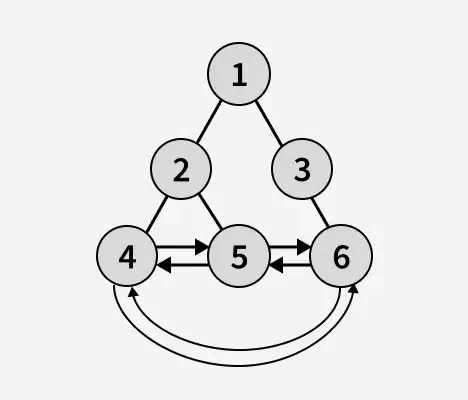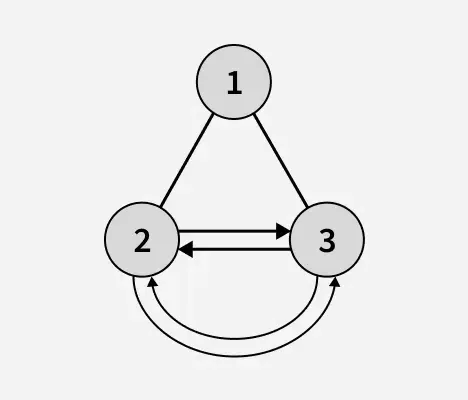Givet a speciellt binärt träd vars lövnoder är anslutna till form a cirkulär dubbellänkad lista uppgiften är att hitta höjd av trädet.
Exempel:
Input:

Produktion: 2
Förklaring: Höjden på binärt träd efter att ha identifierat lövnoderna är 2. I ovanstående binära träd är 6 5 och 4 lövnoder och de bildar en cirkulär dubbellänkad lista. Här kommer den vänstra pekaren på lövnoden att fungera som en tidigare pekare för en cirkulär dubbellänkad lista och dess högra pekare kommer att fungera som nästa pekare för en cirkulär dubbellänkad lista.Input:

Produktion: 1
Förklaring: Höjden på det binära trädet efter att ha identifierat lövnoderna är 1. I ovanstående är binära träd 2 och 3 lövnoder och de bildar en cirkulär dubbellänkad lista.java volatile nyckelord
Närma sig :
C++Tanken är att följa liknande tillvägagångssätt som vi gör för hitta höjden på ett normalt binärt träd . Vi rekursivt kalkylera höjd av vänster och höger underträd till en nod och tilldela höjd till noden som max av två barns höjder plus 1. Men vänster och höger barn till en lövnod är null för normala binära träd. Men här är lövnod en cirkulär dubbellänkad listnod. Så för att en nod ska vara en lövnod kontrollerar vi om nodens vänster till höger pekar på nod och dess höger vänster pekar också på nod sig.
// C++ program to calculate height of a special tree // whose leaf nodes forms a circular doubly linked list #include
// C program to calculate height of a special tree // whose leaf nodes forms a circular doubly linked list #include
// Java program to calculate height of a special tree // whose leaf nodes forms a circular doubly linked list class Node { int data; Node left right; Node(int x) { data = x; left = null; right = null; } } class GfG { // function to check if given // node is a leaf node or node static boolean isLeaf(Node node) { // For a node to be a leaf node it should // satisfy the following two conditions: // 1. Node's left's right pointer should be // current node. // 2. Node's right's left pointer should be // current node. // If one condition is met it is guaranteed // that the other condition is also true. return node.left != null && node.left.right == node && node.right != null && node.right.left == node; } // Compute the height of a tree static int findTreeHeight(Node node) { // if node is NULL return -1. if (node == null) return -1; // if node is a leaf node return 0 if (isLeaf(node)) return 0; // compute the depth of each subtree and take maximum return 1 + Math.max(findTreeHeight(node.left) findTreeHeight(node.right)); } public static void main(String[] args) { Node root = new Node(1); root.left = new Node(2); root.right = new Node(3); root.left.left = new Node(4); root.left.right = new Node(5); root.left.left.left = new Node(6); // Given tree contains 3 leaf nodes Node l1 = root.left.left.left; Node l2 = root.left.right; Node l3 = root.right; // create circular doubly linked list out of // leaf nodes of the tree // set next pointer of linked list l1.right = l2; l2.right = l3; l3.right = l1; // set prev pointer of linked list l3.left = l2; l2.left = l1; l1.left = l3; System.out.println(findTreeHeight(root)); } }
# Python program to calculate height of a special tree # whose leaf nodes forms a circular doubly linked list class Node: def __init__(self data): self.data = data self.left = None self.right = None # function to check if given # node is a leaf node or node def isLeaf(node): # For a node to be a leaf node it should # satisfy the following two conditions: # 1. Node's left's right pointer should be # current node. # 2. Node's right's left pointer should be # current node. # If one condition is met it is guaranteed # that the other condition is also true. return (node.left and node.left.right == node and node.right and node.right.left == node) # Compute the height of a tree def findTreeHeight(node): # if node is NULL return -1. if node is None: return -1 # if node is a leaf node return 0 if isLeaf(node): return 0 # compute the depth of each subtree and take maximum return 1 + max(findTreeHeight(node.left) findTreeHeight(node.right)) if __name__ == '__main__': root = Node(1) root.left = Node(2) root.right = Node(3) root.left.left = Node(4) root.left.right = Node(5) root.left.left.left = Node(6) # Given tree contains 3 leaf nodes l1 = root.left.left.left l2 = root.left.right l3 = root.right # create circular doubly linked list out of # leaf nodes of the tree # set next pointer of linked list l1.right = l2 l2.right = l3 l3.right = l1 # set prev pointer of linked list l3.left = l2 l2.left = l1 l1.left = l3 print(findTreeHeight(root))
// C# program to calculate height of a special tree // whose leaf nodes forms a circular doubly linked list using System; class Node { public int data; public Node left right; public Node(int x) { data = x; left = null; right = null; } } class GfG { // function to check if given // node is a leaf node or node static bool isLeaf(Node node) { // For a node to be a leaf node it should // satisfy the following two conditions: // 1. Node's left's right pointer should be // current node. // 2. Node's right's left pointer should be // current node. // If one condition is met it is guaranteed // that the other condition is also true. return node.left != null && node.left.right == node && node.right != null && node.right.left == node; } // Compute the height of a tree static int findTreeHeight(Node node) { // if node is NULL return -1. if (node == null) return -1; // if node is a leaf node return 0 if (isLeaf(node)) return 0; // compute the depth of each subtree and take maximum return 1 + Math.Max(findTreeHeight(node.left) findTreeHeight(node.right)); } static void Main(string[] args) { Node root = new Node(1); root.left = new Node(2); root.right = new Node(3); root.left.left = new Node(4); root.left.right = new Node(5); root.left.left.left = new Node(6); // Given tree contains 3 leaf nodes Node l1 = root.left.left.left; Node l2 = root.left.right; Node l3 = root.right; // create circular doubly linked list out of // leaf nodes of the tree // set next pointer of linked list l1.right = l2; l2.right = l3; l3.right = l1; // set prev pointer of linked list l3.left = l2; l2.left = l1; l1.left = l3; Console.WriteLine(findTreeHeight(root)); } }
// JavaScript program to calculate height of a special tree // whose leaf nodes forms a circular doubly linked list class Node { constructor(data) { this.data = data; this.left = null; this.right = null; } } // function to check if given // node is a leaf node or node function isLeaf(node) { // For a node to be a leaf node it should // satisfy the following two conditions: // 1. Node's left's right pointer should be // current node. // 2. Node's right's left pointer should be // current node. // If one condition is met it is guaranteed // that the other condition is also true. return node.left && node.left.right === node && node.right && node.right.left === node; } // Compute the height of a tree function findTreeHeight(node) { // if node is NULL return -1. if (node === null) return -1; // if node is a leaf node return 0 if (isLeaf(node)) return 0; // compute the depth of each subtree and take maximum return 1 + Math.max(findTreeHeight(node.left) findTreeHeight(node.right)); } const root = new Node(1); root.left = new Node(2); root.right = new Node(3); root.left.left = new Node(4); root.left.right = new Node(5); root.left.left.left = new Node(6); // Given tree contains 3 leaf nodes const l1 = root.left.left.left; const l2 = root.left.right; const l3 = root.right; // create circular doubly linked list out of // leaf nodes of the tree // set next pointer of linked list l1.right = l2; l2.right = l3; l3.right = l1; // set prev pointer of linked list l3.left = l2; l2.left = l1; l1.left = l3; console.log(findTreeHeight(root));
Produktion
3
Tidskomplexitet: O(n) var n är antalet noder.
Extra utrymme: Åh)


